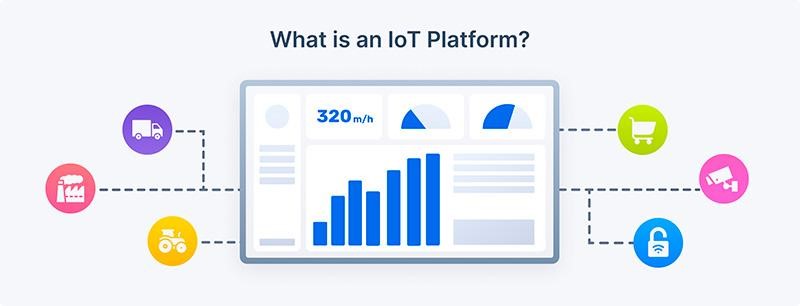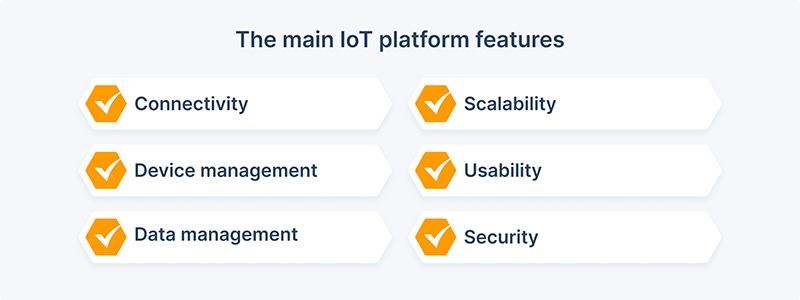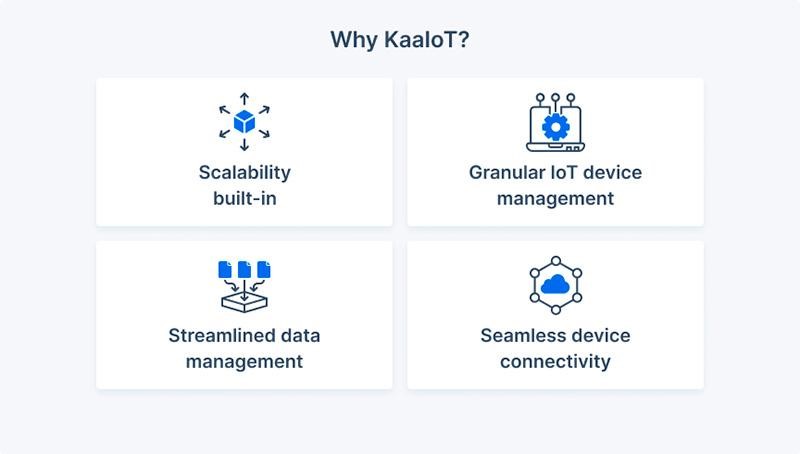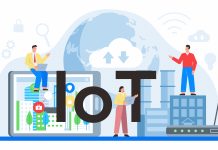The Internet of Things (IoT) is transforming our world, weaving its magic into everything from smart homes to factory floors. Every connected device whispers a data-filled story, waiting to be unlocked. But between you and that treasure trove lies a critical hurdle: choosing the IoT platform.
With countless options vying for your attention, choosing the right IoT platform can be a huge challenge. This guide will equip you with a roadmap to navigate the landscape and choose the best IoT platform to meet your exact needs, addressing the question of “how to choose the IoT platform.”
In this article, we’ll dissect the essential IoT platform features that truly matter, helping you identify which ones align with your project’s DNA.
Step 1. Understanding IoT basics
In the dynamic realm of the IoT, foundational comprehension sets the stage for an effective and strategic journey. Let’s dive into the basics of the IoT.
What is an IoT platform?
Think of an IoT platform as the brains behind your connected IoT devices. It serves as a crucial bridge, collecting data from sensors, managing devices, and providing essential tools for analysis and visualization.

Essentially, an IoT platform orchestrates the seamless integration of devices, ensuring efficient communication and offering a centralized IoT hub for comprehensive control and management within the IoT ecosystem.
The main types of IoT platforms
Let’s unpack the different types of platforms available, each specializing in a different aspect of IoT infrastructure.

- Cloud IoT platforms
A cloud IoT platform is a versatile solution that provides a comprehensive suite of tools for IoT device management, data analytics, and application development. Hosted in the cloud, these platforms offer scalability, accessibility, and centralized control, making them integral for efficient IoT deployment and management.
- IoT connectivity platforms
IoT connectivity platforms specialize in facilitating seamless communication between IoT devices and the central platform. They offer pre-built connectors and APIs supporting various protocols, simplifying the process of device interconnectivity. These platforms are essential for ensuring efficient and reliable communication within an IoT ecosystem.
- IoT analytics platforms
While it’s true that every IoT provider processes IoT data in some way, IoT analytics platforms go beyond basic data processing, providing advanced tools for visualizing, transforming, and deriving actionable insights from IoT device data. They enable users to uncover deeper trends, trigger actions, and gain valuable insights, enhancing the understanding and utilization of data generated by IoT devices.
Why do you need an IoT platform?
Connect and manage devices
Managing individual devices will no longer be a problem. An IoT platform lets you connect, configure, monitor, and update your entire fleet remotely, saving valuable time and resources.
Collect and analyze data
Unleash the insights hidden within your devices’ data. IoT platforms offer tools to visualize trends, identify anomalies, and make data-driven decisions.
Streamline IoT deployment
IoT platforms also streamline deployment by eliminating the need to reinvent the wheel. With pre-built connectors, APIs, and development tools, they accelerate your time-to-market, ensuring that your IoT solution hits the right notes quickly and efficiently.
Improve and streamline operations
By integrating IoT data with data from other sources, you get a more complete picture of your whole company. This, in turn, can lead to more efficient operations and quicker progress toward your business goals.
In essence, an IoT platform becomes the strategic backbone, aligning devices, data, and operations for a harmonious and efficient IoT deployment.
Step 2. Deconstructing your IoT project’s DNA
Before comparing IoT platforms, it’s imperative to take the essence of your project into consideration. Ask strategic questions that lay the foundation for informed decision-making.
- What problem are you solving?
Are you optimizing energy consumption, monitoring remote assets, or personalizing user experiences? Clarifying the problem statement provides a clear roadmap for the functionalities your chosen platform must possess.
- What data will your devices generate?
Whether it’s temperature readings, machine sensor data, or user behavior patterns, understanding the nature of the data generated by your devices is crucial for selecting a platform with appropriate data processing and analytics capabilities.
- How many devices will you connect?
Whether it’s ten smart thermostats or thousands of industrial sensors, the scale of your IoT deployment impacts platform compatibility. Different platforms are designed to handle varying volumes of connected devices, ensuring scalability for your project’s growth.
Understanding your project’s DNA will guide you towards platforms that excel in your specific areas of need.
Step 3. Decoding the IoT platform feature jungle
As you navigate the diverse landscape of IoT platforms, decoding their intricate IoT platform features is paramount to aligning technological capabilities with the unique requirements of your project. Now, let’s explore the core features that differentiate cloud platforms.

Connectivity
Evaluate the platform’s support for your chosen protocols, be it MQTT, Zigbee, or others. Additionally, check for pre-built connectors tailored to your specific devices, ensuring seamless integration within your IoT ecosystem.
Device management
Scrutinize the cloud IoT platform’s device management capabilities. Can you remotely configure settings, schedule updates, and monitor device health? Look for features like role-based access control to facilitate secure team collaboration.
Data management
Explore the platform’s data management offerings. Does it provide robust storage, visualization tools, and integration with analytics platforms? Assess whether you can define custom alerts and create data pipelines to streamline your data processing.
Scalability
Gauge the cloud platform’s scalability. Assess whether it can effortlessly handle the projected growth of your IoT device fleet and the increasing volume of data without compromising performance.
Usability
Consider the user-friendliness of the platform’s interface. Is it intuitive for non-technical users? Ensure that you can easily access relevant data and manage devices without the need for an engineering degree.
Security
Prioritize IoT platform security features. Does the platform offer robust encryption, multi-factor authentication, and data privacy measures? Verify its compliance with relevant industry regulations to safeguard your data and operations.
In addition to these core IoT platform features, tailor your evaluation based on project-specific priorities. Depending on your objectives, you might emphasize industrial IoT protocols, real-time analytics capabilities, or the availability of a user-friendly mobile app for device control. By dissecting the IoT platform feature jungle, you empower yourself to make informed choices aligned with the nuanced requirements of your IoT project.
Step 4. Comparing IoT platforms
Now that you possess a deep understanding of your project’s DNA and the essential features of different platforms, you’re ready to embark on the exciting quest of how to choose the IoT platform that perfectly complements your needs. Buckle up as we navigate the intricate landscape of IoT platform comparison through the lens of key evaluation areas.
- Device management capabilities
Evaluate whether the platform seamlessly accommodates your specific device types and protocols. Can it handle the intricacies of your devices, offering the desired level of remote control and security? A robust device management system is pivotal for efficient control and monitoring of your IoT fleet.
- IoT platform security
Scrutinize the platform’s security measures. Does it employ industry-standard encryption, authentication, and access control protocols? Confirm the existence of clear data privacy policies and relevant compliance certifications to ensure the protection of sensitive data and compliance with industry standards.
- Analytics and data management capabilities
Assess the platform’s analytics and data management offerings. Does it provide built-in analytics tools, or does it seamlessly integrate with your preferred Business Intelligence (BI) platform? Consider whether the platform facilitates the creation of custom IoT dashboards and data pipelines, enabling you to derive deeper insights from your IoT data.
- IoT platform pricing models
Explore the various pricing models offered by each platform. Whether it’s pay-as-you-go, subscription tiers, or upfront costs, choose a pricing model that aligns with your budget and projected device growth. Understanding the cost structure is integral to ensuring the long-term sustainability of your IoT deployment.
By scrutinizing these key areas, you can make an informed decision about selecting the IoT platform that not only aligns with the specifics of your project but also provides the flexibility and scalability necessary for future growth. This comparative analysis ensures that your chosen platform is not only a technological match but also a strategic investment for the continued success of your IoT initiative.
KaaIoT: the most flexible IoT platform
If you’re looking for a solution that is both flexible and scalable, look no further than KaaIoT. This cloud-based platform caters to diverse needs, seamlessly integrating with various devices and protocols. Its intuitive interface and robust security features make it ideal for beginners and seasoned developers with expertise in IoT technology alike.
Why KaaIoT?

Scalability built-in
KaaIoT seamlessly scales to accommodate your growing fleet, ensuring your platform grows with your ambition.
Granular IoT device management
Remotely configure, monitor, and update your devices with ease. Role-based access control ensures data security and team collaboration.
Streamlined data management
Store, visualize, and analyze your data with built-in tools. Integrate seamlessly with existing data lakes or BI platforms for holistic insights.
Seamless device connectivity
KaaIoT offers pre-built connectors for popular devices, saving you valuable development time.
Conclusion
Remember: choosing the right IoT platform is a marathon, not a sprint. Invest time in research, comparison, and even consultations with experts. The perfect platform awaits, ready to unlock the true potential of your IoT project.






